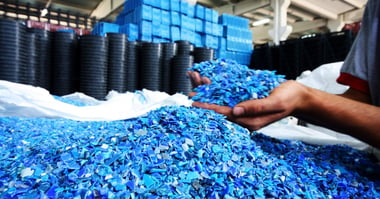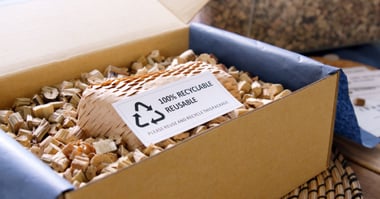
Beth Howell
Beth has been writing about the environment and climate change for over four years now – with her work being featured in publications such as The BBC, Forbes, The Express, Greenpeace, and in multiple academic journals.
As people continue to become increasingly aware of their impact on the planet, the demand for sustainable practices is growing across all sectors — and ecommerce is no exception.
Adopting sustainable practices in your ecommerce business benefits the planet while also appealing to the growing group of conscious consumers.
Not sure where to start when it comes to making your ecommerce business more sustainable? In this guide, we’ll provide a step-by-step guide on how to do this, transforming your ecommerce business into a sustainable powerhouse.
What’s on this page?
01 | What is sustainable ecommerce?02 | 13 ways to make your ecommerce business more sustainable
03 | Summary
What is sustainable ecommerce?
Sustainable ecommerce refers to the practice of conducting online business in a way that minimizes environmental impact and promotes social responsibility.
It involves adopting practices that reduce your carbon footprint, ensure ethical sourcing, minimize waste, and create a positive impact on society.
But sustainable ecommerce isn’t just about selling eco-friendly products — it encompasses every aspect of the business, from product sourcing and packaging to logistics and marketing.
Want to learn more? Find out everything you need to know by visiting our page: What is Sustainable Ecommerce?
13 ways to make your ecommerce business more sustainable
There’s never been a better time to navigate towards more sustainable operations in ecommerce.
A recent survey found that 72% of respondents reported that they were actively buying more environmentally friendly products than they did five years ago.
Want to attract more of these eco-conscious customers? You’ll need to make your ecommerce business more sustainable — and here’s how.

1. Evaluate your current environmental impact
Before making any changes across the business, it’s important to assess your current environmental impact. This way, your metrics and reporting will be more accurate and trustworthy — not to mention you’ll have a better idea of the task at hand.
The key way to do this is by conducting a sustainability audit. You can either hire a professional or use tools, like the Environmental Protection Agency’s (EPA) carbon footprint calculator, to measure your current impact to identify key areas for improvement.
It’s also important to look at your supply chain, packaging, shipping methods, and energy usage to pinpoint areas where you can reduce your environmental footprint.
2. Look into sustainable product sourcing
Now you’ve got a better understanding of your current environmental impact, the next step is to improve your sourcing process.
Sustainable product sourcing involves choosing materials and suppliers that prioritize environmental and social responsibility — that means you should choose eco-friendly materials and work with ethical suppliers.
- Choose eco-friendly materials: Instead of relying on harmful materials like plastic, polyester, and nylon, make sure your products are made from sustainable materials, such as organic cotton, bamboo, and recycled plastics are excellent alternatives. And bare in mind that you should avoid mixing these materials where possible, otherwise, you run the risk of making the product difficult to recycle
- Work with ethical suppliers: Your environmental impact also comes down to the companies you work with. Make sure your suppliers follow fair trade practices, provide safe working conditions, and pay fair wages. Certifications like Fair Trade, Global Organic Textile Standard (GOTS), and Forest Stewardship Council (FSC) can help you figure out whether your suppliers follow these practices
3. Reduce unnecessary packaging
A recent study found that ecommerce generates around 4.8 times more packaging waste than in-store purchasing.
To combat this waste, ecommerce companies can utilize recycled cardboard, plastic, paper, or glass — a simple and easy way to encourage circularity. This could have a major impact on company carbon emissions, with recycled plastic taking nearly 70% less energy to make than new plastic.
Opting for recycled materials can also save businesses money since some countries — including the UK, Italy, and Spain — currently have plastic taxes in place.
Of course, packaging is unavoidable for some products. In this case, it’s worth trying to reduce the amount of packaging as much as possible and opt for recyclable materials to make sure you can still be part of the circular economy.
4. Optimize logistics and shipping
Ecommerce transportation accounts today for 3% of global greenhouse gas emissions, which is on track to become 17% by 2050.
What are the two main factors driving this increase in emissions? Growing demand and consumption of fossil fuels.
Ecommerce businesses can reduce their impact on the planet by switching to a fleet of vehicles that run on electricity. One study found that electric vehicles (EVs) release up to 43% fewer emissions than diesel vehicles.
You can even optimize your delivery routes by using software to reduce fuel consumption and emissions. Consolidating shipments can also help reduce the number of trips needed.
Alternatively, why not experiment by offering green delivery options to your customers? Give customers the choice of slower, more sustainable shipping methods, which often have a lower environmental impact than next-day delivery.
5. Make operations more energy efficient
Improving energy efficiency in your operations can significantly reduce your overall environmental footprint. In fact, some studies suggest that increased energy efficiency can reduce industrial carbon emissions by up to 34% in some sectors.
One key way you can do this in your ecommerce business is by upgrading to energy-efficient equipment — use LED lighting, energy-efficient HVAC (heating, ventilation, and air conditioning) systems, and Energy-Star-rated appliances.
It’s also worth utilizing renewable energy sources, whether that’s by installing solar panels on your buildings or opting for a renewable energy tariff.
And remember, we’re doing this for the long haul, so make sure to conduct regular energy audits. There will always be areas where you can improve energy efficiency and implement changes accordingly.

6. Introduce sustainable marketing practices
Marketing is often overlooked in sustainable operations, but it plays a crucial role in attracting eco-conscious consumers.
If you want your sustainable ecommerce business to do well, you need to make sure you promote your sustainability efforts in marketing campaigns to build trust and attract environmentally conscious customers. But remember: back up all your claims with evidence and research to avoid greenwashing allegations.
Looking to reach a wider audience? It’s a good idea to collaborate with eco-friendly influencers who share your commitment to sustainability.
Your marketing department should also practice what they preach — for example, they can reduce paper waste by focusing on digital marketing strategies like email, social media, and content marketing.
7. Build a sustainable company culture
If you want to reduce your impact on the planet, you need to integrate sustainability into every aspect of your business.
Although this sounds like a mammoth task, it can be done in a few simple steps:
- Educate your team: Provide training on sustainable practices and the importance of sustainability — especially in departments that are at the forefront of your sustainability plan
- Encourage employee involvement: Create programs that allow employees to contribute ideas and participate in sustainability initiatives
- Lead by example: Demonstrate your commitment to sustainability through your actions and decisions as a leader.
8. Remove recycling barriers
Consumers want to make responsible choices, but recycling often presents a confusing barrier. In fact, 42% of people who are unsure about a product’s recyclability will take a guess, meaning items can easily end up contaminating the recycling stream.
As a business, it’s impossible to account for the huge range of recycling systems around the world, but you can give customers a leg up by providing some guidance on how to recycle your products.
Telling people what they should do with your packaging can be a fun, engaging way to signpost your commitment to the planet.
For example, Yeo Valley prints instructions directly on some of their products, using their brand style to show customers exactly how things should be separated before disposal.
9. Reduce return rates
Ecommerce has made it easier than ever to buy products — but it’s also made it far too easy to return items. In fact, one in three items bought online now are returned, which is much higher than the 9% return rate for items purchased in-store.
A lot of those returns are the result of damaged products, but as many as 64.2% are the result of poor product descriptions. So to avoid this from happening as frequently, it’s worth auditing your existing product descriptions, making sure they’re accurate and up-to-date.
Want to take it a step further? Create an automated email flow to ask customers why they returned items, and what could have been clearer.
More online shoppers are also giving into the ‘buy, try, return’ culture, which means they have the intention of returning the entire order after trying on items for social media. It’s worth assessing how your returns policy can prevent this from happening.
While it may seem counterintuitive, research from the University of Texas-Dallas found that lengthening policies to 60 (or even 90 days) can lead to fewer returns as it removes the element of urgency.
When customers are given more time to test out whether they like the product, they are less likely to return it.
10. Try “recommerce”
“Recommerce” involves selling previously owned items through online marketplaces.
This market has been growing rapidly in recent years, as consumers become more open to the idea of buying second-hand items — especially in certain industries, like fashion, interior, and tech.
According to GlobalData, the clothes resale market in the UK grew by 149% between 2016 and 2022, and is forecast to rise by a further 67.5% from 2022 to 2026.
If your business works in a recommerce-friendly industry, it’s definitely worth setting up a platform that will allow your customers to buy second-hand items.
11. Host your ecommerce site on a green platform
When businesses want to reduce their carbon footprint, excess packaging and high-emission transport issues are often the first port of call. But something that’s often overlooked is the site that hosts the ecommerce platform.
Why is this an area of concern? Well, websites rely on servers that often run on fossil fuels.
As a result, it’s estimated that the average website produces 4.61 grams of CO2 for every page view. For websites that have an average of 10,000 page views per month, that leads to 553 kilograms of CO2 per year.
If you’re trying to make your ecommerce business more sustainable, it’s worth looking into a green hosting platform, like Shopify.
Shopify decommissioned all of its physical data servers in 2018 and moved its entire platform to Google Cloud — a green hosting solution, powered by 100% clean, renewable energy.
12. Offset your impact
For some industries, completely avoiding packaging will be challenging — and in some cases, impossible. For example, industries with certain hygiene laws and safety procedures will find it hard to avoid using single-use protective gear until a better alternative comes along.
But that doesn’t mean these businesses have to accept a hefty plastic footprint. They can also fund waste recovery to offset the amount of plastic they consume, whilst also working on areas of improvement in the production line.
Juice company PRESS provides a key example of how to do this effectively. This innovative company has introduced eco-friendly materials into its production line, with recycled plastic making up 75% of its bottles, and bioplastics making up the rest. To offset the waste they can’t remove just yet, PRESS partners with us to fund waste recovery efforts in vulnerable coastal areas.
As a result, the company has now become “plastic neutral” and has helped improve the lives of waste pickers in developing nations in the process.
13. Continue to measure and report on your sustainability progress
Sustainability is an ongoing journey, not a one-time achievement. That’s why it’s important to always keep improving your ecommerce business’s environmental impact.
One of the best ways to do this — and one of the most overlooked tips — is by regularly seeking feedback from customers, employees, and stakeholders to identify new opportunities for improvement.
Of course, you should also be keeping up with the latest sustainability trends, technologies, and regulations to continually improve your practices.
Above all, you’ll need to communicate all of this positive change with your audience and the wider public. Transparency and accountability are key to maintaining trust with your customers and stakeholders — not to mention it can attract new customers! Here are the top ways we’d recommend being transparent about your sustainability goals:
- Set measurable goals: Define clear, achievable sustainability goals and track your progress regularly.
- Use sustainability reporting frameworks: Follow established frameworks like the Global Reporting Initiative (GRI) or the Carbon Disclosure Project (CDP) to report on your sustainability efforts.
- Communicate your progress: Share your achievements and areas for improvement with your customers, employees, and stakeholders through regular updates.
Summary
Becoming a sustainable ecommerce business is not only a responsible choice but also a strategic one. By adopting sustainable practices, you can reduce your environmental footprint, attract eco-conscious consumers, and build a positive brand image.
With these steps, you can transform your ecommerce business into a model of sustainability and make a positive impact on the planet.

.webp)
.webp?width=380&name=Sustainable%20christmas%20(1).webp)
.webp?width=380&name=Sorting-trash%20(1).webp)
.webp?width=380&name=ESG-presentation%20(1).webp)


.webp?width=380&name=Buying-online%20(1).webp)

.webp?width=380&name=Plastic-on-the-beach%20(1).webp)
.webp?width=380&name=Sales%20(1).webp)

